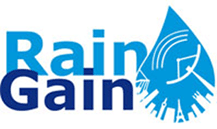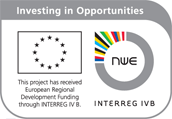Fine-scale rainfall data acquisition and prediction
Objective
The objective of WP2 is to develop and implement a system for estimation and forecasting of local rainfall on the basis of data, acquired from rainfall radars in combination with traditional rainfall measurement devices. This system will be applicable for urban areas of North-West Europe. It will make use of fine scale radar technology (X-band and super-resolution C-band), and will allow local city managers to forecast, warn about and control urban pluvial impacts such as inundations at street- or house-scale.
The actual rainfall estimates should enable city water managers to develop reliable urban water strategies, including plans for urban flood prevention and pollution management. The rainfall forecasts will enable the city water managers to make flood forecasts at street level in real time. This requires the rainfall estimates and forecasts to be obtained at fine scale both in space and time. The spatial scale needs to be in the order of magnitude of 100 meters, while the time scale needs to be in minutes (due to the quick time in which an urban sewer system reacts to rainfall over the area).
Actions and investments
- Action WP2 A5: Exchange of experiences gained on the use of fine scale (X-band and super-resolution C-band) radar data, combined with other existing rainfall data, for street level rainfall estimation. During an international workshop to be held in Leuven, in autumn 2012, attended by radar experts from the partner institutions and invited national radar experts from the partner countries, common methods will be agreed upon for street level rainfall estimation.
- Action WP2 A6: Implementation of common method and technology for fine scale rainfall estimation (for present and past rain storms). The common method and technology agreed upon during the workshop WP2 A5 will be applied to all four pilot locations (Leuven, Paris, Rotterdam, London). The added-value of the X-band and super-resolution C-band radars will be shown by comparing the accuracy of the fine-scale radar estimates to the best estimates that could be made in the absence of the X-band or super-resolution C-band radar.
- Action WP2 A7: Exchange of experiences on the real-time forecasting of fine scale rainfall, during an international workshop in London, to be held in spring 2014, attended by radar and rainfall forecasting experts from the partner institutions and invited national experts on numerical weather prediction. A common method will be agreed upon for street level rainfall forecasting.
- Action WP2 A8: Based on the outcomes of theWP2A7 workshop, the agreed common method for rainfall forecasting will be implemented for each of the four pilot locations (Leuven, Paris, Rotterdam, London), resulting in an operational system for local rainfall forecasting.
- Action WP2 A9: Set up of customised guidelines for fine-scale rainfall estimation and forecasting in urban areas in the partner countries. The guidelines will allow the generic application of the technology in any urban area in NW Europe. Training and dissemination on these standards and technology will be provided national observer meetings
Transnational added value
- Positive research experience gained in Europe on the use of the new X-band radar technology and super-resolution C-band radar technology for fine scale rainfall estimation and forecasting will be exchanged, and common technology implemented and guidelines developed.
- To obtain the fine scale rainfall forecasts, the X-band and super-resolution C-band radar data (which in itself only cover a small geographic area), need to be integrated with the numerical weather prediction provided by the national meteo-services. For our regions, this weather prediction typically operates at the larger scale of NW Europe. Common technology for this region thus is most efficient.
- The intended users of the local rainfall estimation and forecast technology (city administrations or management boards that are operating at the scale of relatively small regions) in general do not have the capacity or the financial means to develop and implement such technology themselves.
By bringing together in the project consortium key research partners, selected users (cities, water authorities), industrial partners (such as Aquafin and Veolia, who play an important interfacing role between the research partners and the end users) and from different countries, sufficient critical mass is brought together to develop and implement the technology. In the end the technology will be available for use by all local managers of urban areas in NW Europe.
- The project will make use of what is already available in both X-band based rainfall estimates and forecasts in some partner countries (e.g. Belgium, France) and next generation of C-band radar based forecasts (UK, France) with the necessary upgrades that we will make in cooperation with the meteorological partners. Through sharing of the expertise and testing of the technologies under different conditions, consistent NW European “wisdom” will be created that aims to be world leading.
Who is doing what ?
- WP2 A5: K.U.Leuven will organize the international workshop on “state of the art fine scale rainfall estimation” and will invite the radar experts from the partner institutions and national radar experts from the partner countries. K.U.Leuven will prepare a report describing the outcomes of the workshop, including a description of the common method for fine scale rainfall estimation.
- WP2 A6: ParisTech, TU Delft, K.U.Leuven, MetOffice and ICL will apply the agreed fine scale rainfall estimation method to the pilot location in their country. The results will be used in WP3 and WP4 in support of urban flood modelling and prevention. They also will be used for demonstration and training purposes in WP2 A9.
- WP2 A7: ICL will organize the international workshop on fine scale rainfall forecasting. K.U.Leuven will prepare a report describing the outcomes of the workshop, including a description of the agreed common technology which allows generic in any urban area in NWE.
- WP2 A8: ParisTech, TU Delft, K.U.Leuven, MetOffice and ICL will implement the common technology for fine scale rainfall forecasting for the pilot location in their country. They will cooperate with the national meteo-services for the integration with the numerical weather forecasting. The results will be used in WP3 and WP4 in support of urban flood forecast, control and prevention. They also will be used for demonstration and training purposes in WP2 A9.
- WP2 A9: The customized guidelines for rainfall estimation and forecasting will be set up based on the outcomes of the different WP2 Actions. K.U.Leuven will draft these guidelines, will collect comments by the other partners and selected experts from the partner countries, and will finalise. ParisTech, TU Delft, K.U.Leuven and ICL will organize a training and dissemination workshop for members of the observer groups (one workshop in each partner country).
Outputs
- WP2 A5: Agreement on common methods for street scale rainfall estimation in urban areas in NW Europe. This agreement will be the main outcome of the workshop of WP2 A5, discussed by about 20 radar experts from the partner institutions and national radar experts from the partner countries.
- WP2 A6: Street scale rainfall estimates obtained for each of the pilot locations (one in each partner country), afte``r combining the new X-band radar technology with super-resolution C-band radar data and rain gauge data. The added-value of these fine scale rainfall estimates are quantified in terms of accuracy differences with rainfall estimates when no use would be made of the new technology.
- WP2 A7: “Common core” technology for fine scale rainfall prediction integrated in operational systems for numerical weather prediction in NW Europe, agreed as main outcome of the workshop of WP2 A7, discussed by about 20 radar experts from the partner institutions and national experts in numerical weather prediction from the partner countries.
- WP2 A8: “Common core” technology for fine scale rainfall prediction implemented for each pilot location; Pre-operational system for street scale rainfall forecasting for each pilot location; Local rainfall forecasts for minimum 10 extreme rainfall storms during the period of available radar data (to be used in WP3 and WP4 for urban flood forecasting and control).
- WP2 A9: Customised guidelines for rainfall estimation and prediction in the partner countries; About 20 people per partner country trained on the application of the common technology (these people are end users – city flood managers, water managers, consultants and industrial partners – of the fine scale rainfall estimation and forecasting technology).



